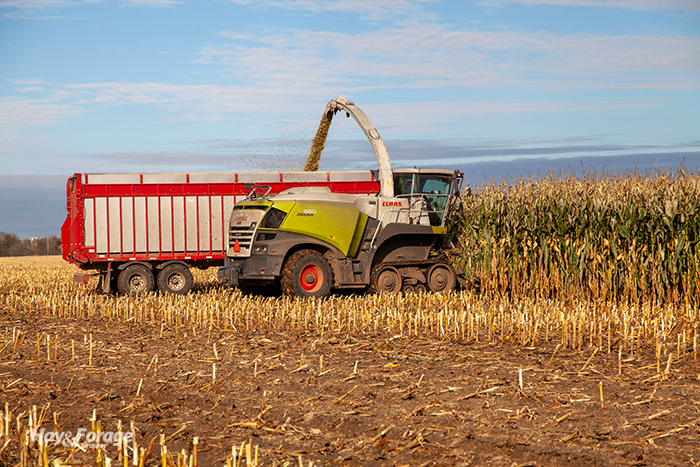
In a recent Hoard’s Dairyman webinar, John Goeser compared the corn silage growing season to a football game. Metaphorically speaking, he said farmers had the ball going into the fourth quarter, but now the goal is to score on harvest with proper management, storage, and eventually, feedout.
Goeser is a dairy nutrition and management consultant with Progressive Dairy Solutions Inc. According to him and his colleagues, the theme of this year’s corn silage crop is quite different than previous years, especially considering the variation in late season scouting reports from across the country.
When he polled the audience during the live webinar, the majority of participants reported a wet start to the growing season. Seeing this, Goeser explained research from Joe Lauer at the University of Wisconsin-Madison that shows wet growing seasons negatively affected corn silage neutral detergent fiber digestibility (NDFD) compared to average and dry years.
“For wetter starts to the season where we have above-average to excessive rainfall, our fiber digestibility trends down.” Goeser said. He added that warm, wet weather also amplifies disease pressure, especially when these conditions exist during silking.
There are many aspects of corn silage that impact dairy cow performance, but Goeser emphasized the roles that fiber and starch content and digestibility play in energy density. In fact, these nutrients can comprise roughly 70% of the total caloric value of corn silage. And since corn silage accounts for $2 to $3 per hundredweight (cwt.) of milk production in terms of feed costs, fiber and starch carry a lot of economic value, too.
“That is a huge component of our feed cost, and we shouldn’t need any more economic incentive to seek ways to improve our forage quality and yield so that we are optimizing what each acre gives us in terms of digestible nutrients,” Goeser said. Therefore, he offered advice — and other nutritionists’ observations — to make the most of this year’s corn silage in several regions of the U.S.
Wisconsin: Agronomists reported variable crop progress across the country’s top state in corn silage production. Goeser noted that farmers in eastern Wisconsin faced high disease pressure, but proactive fungicide applications will likely salvage plant health.
In central Wisconsin, variable weather conditions may warrant more intensive harvest and storage management in order to secure high-quality silage. In western Wisconsin — and parts of Minnesota — corn plants are growing taller than average, reaching up to a foot higher than normal. Goeser suggested this might offer an opportunity to raise the chopping height and capture better feed value without sacrificing significant yield.
“The more leafy tissue we have — the less midrib and the less stover we have — the greater fiber digestibility. However, if plants are stretching out and are taller, we have a little more stalk and the internode spacing is greater, and that can hamper fiber digestibility,” he explained.
South Dakota: So far, the South Dakota corn crop appears to be in above-average condition. However, Goeser noted that even though early planting paired with higher planting populations could boost yields, this may negatively affect feed value. “You might want to do some work checking forage quality,” he said to South Dakota farmers.
Idaho: The trendline for corn silage quality in Idaho is like a camel with two humps — it’s either really good or really bad, Goeser said. The difference could be attributed to planting date and whether corn was put in the ground early or following a cover crop later in the spring when conditions turned hot and dry. Idaho farmers have also experienced heavier pest pressure this summer, and with a dry spell in the forecast, Goeser encouraged farmers there to scout fields and communicate with their custom harvesters to target the best time to chop if they haven’t started already.
California: Goeser reported on moderate summer weather along the West Coast, and farmers who harvested early season corn silage captured good to great starch levels, as well as good fiber digestibility. “By and large, we have an average to above-average crop in California with the potential for some great silage” Goeser said.
New York: Considering the excess rainfall that delayed hay cutting and corn planting in New York this spring, Goeser encouraged farmers to think outside the box to secure forage supplies and balance rations with purchased ingredients. “Maybe we can’t feed the traditional high-forage diets that we’ve been able to in the Northeast, but there are other options,” he said, suggesting that commodities, such as soyhulls, can help fill gaps in dairy diets without going over budget.
Indiana and Ohio: Goeser expects corn silage quality in Indiana and Ohio to be “sneaky good.” Later planting dates coupled with a hotter, drier growing season limited plant height, which he predicts will enhance NDFD. Agronomists in these states also report excellent pollination, which should boost silage energy density.
Michigan: Referring back to his football analogy, Goeser said corn silage production in Michigan looks like it will be more of a tie game than a guaranteed win. “We had some delayed planting due to some untimely rains earlier this year in Michigan,” he noted. “Of all the regions that we covered today, this is the one with the widest amount of unknown yet to play out.”
Overall, Goeser encouraged farmers to continue to scout fields and reassess their goals as chopping gets underway. “As we carry forth with harvest, be safe, step up your communications, and work with your agronomist and harvesting crew,” he concluded.

